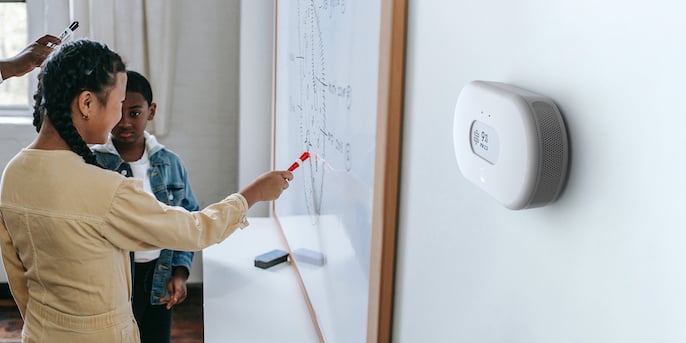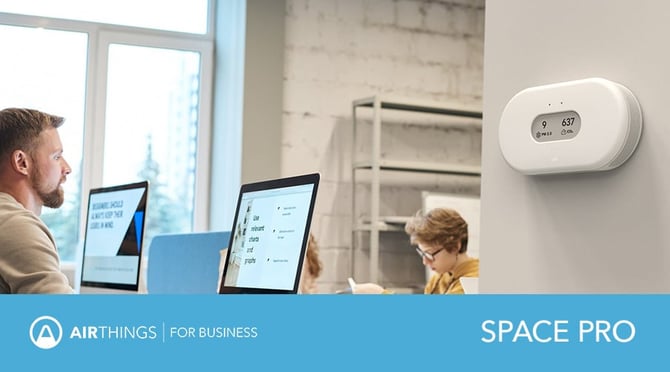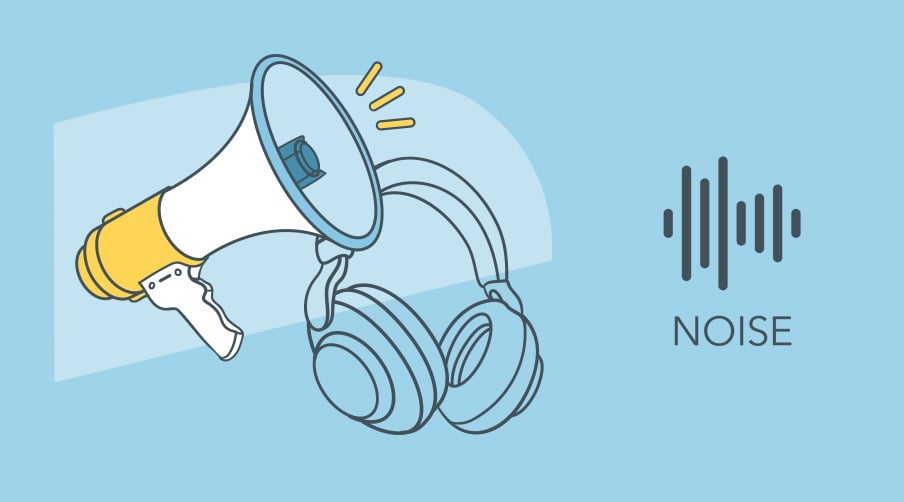We have all been told to “keep the noise down” at some point in our life. It’s distracting as it is annoying, but how can monitoring noise, without recording it of course, positively impact our working environment? In this article we explore just this, and explain why noise monitoring is a necessity for every industry.
Contents:
Nothing gets recorded
The first thing to point out, with the Airthings for Business solution, is that no sound is recorded. The focus is on volume. As we know, noise levels are measured in decibels (dB), and the louder the noise, the higher the decibels. Decibels can be adjusted to human hearing. Noise level is thus described in decibels A (dBA)1.
Therefore, the solution provides you with your average levels over a period of time, shown in a dBA graph, to help you identify the loudest periods. This can help you determine if your workspace is optimal or not, for concentration, stress levels and productivity.
Ensure a healthy working environment
Noise can be distracting, as we are well aware. The fewer interruptions in the office or educational buildings for example, will boost your productivity and concentration. Similarly for healthcare environments less noise can create a peaceful environment to better help those in recovery.
The Center for Disease Control (CDC) estimates that 22 million workers are exposed to potentially damaging noise at work each year.2
Noise monitoring has long been a standard in more ‘conventionally’ noisy workplaces. At construction sites you will see for example workers wearing ear protection as well as hard hats, the same goes for factories and their workers. So why is the office, or health care environment a good place to measure to? Surely the noise levels cannot be that high?
.jpg?width=686&name=blogAirthings%20View%20Plus%20for%20Business%20-%20Lifestyle%20Office_PM_CO2_Close-up_WEB%20(1).jpg)
86% of schools exposed to road traffic
On the contrary. In fact, one study which measured 142 schools in the UK and found that “86% of the schools surveyed were exposed to noise from road traffic, the average external noise level outside a school being 57 dB LAeq”3. What is even more interesting is that these particular schools were situated away from flight paths into major airports. And that is just the sound from outside the building. Imagine adding talkative school children into this already noisy environment.
To put this into context, the World Health Organization (WHO) suggest that “When listening to complicated messages (at school, foreign languages, telephone conversation) the signal-to-noise ratio should be at least 15 dB with a voice level of 50 dB(A).”4 This is for people speaking casually at a 1m distance. In this scenario, WHO determined that “Consequently, for clear speech perception the background noise level should not exceed 35 dB(A).”5

The open plan office conundrum
In an office, background noise is part of the package. Co-workers brainstorm ideas, or gossip at the office cooler. In fact, background noise for some is part of the office charm. During the pandemic, the BBC reported that “Fake background office chatter” is helping some work from home more productively6. So when does office noise become a nuisance?
In what we might call ‘the open plan office conundrum’, modern architecture leans towards the open plan office to foster a collaborative and more relaxed working environment. However, at the same time, this can also create a distracting place to work. The Francis Crick Institute in London, experienced just this problem. Though marvelled for its design, the Guardian reported that the £700m building was “too noisy to concentrate” in7.
The fact of the matter is, that we all experience sound differently, some enjoy the background hum, some prefer steely silence, and we all know a disturbingly loud noise when we hear one. The key is volume. The National Institute for Occupational Safety and Health (NIOSH) has recommended that all worker exposures to noise should be controlled below a level equivalent to 85 dBA for eight hours to minimize occupational noise induced hearing loss8. Taking measures to ensure that high volume is not consistent over a long period of time can help to produce an optimal environment for concentration, stress levels and productivity.
Want to learn more about the most comprehensive indoor air quality monitor in the Airthings for Business solution, including PM, Noise, and more? Get even more control over your space today with Space Pro (formerly View Plus for Business) →

Sources:
1. www.quebec.ca/en/health/advice-and-prevention/health-and-environment/the-effects-of-environmental-noise-on-health/noise-measurement/
2. https://www.osha.gov/noise
3. https://core.ac.uk/download/pdf/111617.pdf
4. https://www.who.int/docstore/peh/noise/Comnoise-1.pdf
5. https://www.who.int/docstore/peh/noise/Comnoise-1.pdf
6.https://www.bbc.com/news/business-53724338
7. www.theguardian.com/science/2017/nov/21/francis-crick-institutes-700m-building-too-noisy-to-concentrate
8.https://www.osha.gov/noise#:~:text=The%20National%20Institute%20for%20Occupational%20Safety%20and%20Health%20(NIOSH)%20has,occupational%20noise%20induced%20hearing%20loss.
 Most popular
Most popular

 Radon
Radon



 Radon
Radon
 Radon
Radon


.webp)

.jpg?width=686&name=blogAirthings%20View%20Plus%20for%20Business%20-%20Lifestyle%20Office_PM_CO2_Close-up_WEB%20(1).jpg)

